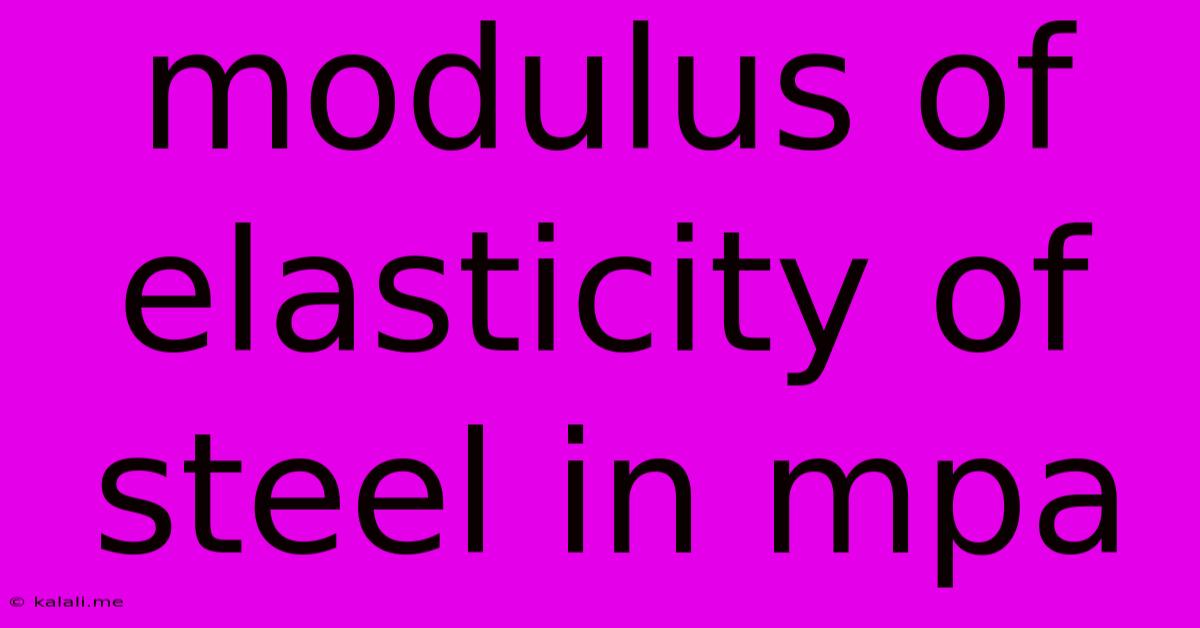Modulus Of Elasticity Of Steel In Mpa
Kalali
Jun 15, 2025 · 3 min read

Table of Contents
Modulus of Elasticity of Steel in MPa: A Comprehensive Guide
The modulus of elasticity, also known as Young's modulus, is a crucial material property that describes a material's stiffness or resistance to deformation under stress. For engineers and designers, understanding the modulus of elasticity of steel is paramount for calculating stress, strain, and deflection in structural applications. This article delves into the modulus of elasticity of steel, exploring its variations, influencing factors, and practical implications. Understanding this fundamental material property is key to ensuring the safety and reliability of steel structures.
What is the Modulus of Elasticity?
The modulus of elasticity (E) represents the ratio of stress (force per unit area) to strain (deformation per unit length) in the elastic region of a material's stress-strain curve. In simpler terms, it quantifies how much a material will deform under a given amount of load before it begins to permanently deform (yield). A higher modulus of elasticity indicates a stiffer material, requiring greater stress to produce a given amount of strain.
Modulus of Elasticity of Steel: Typical Values
The modulus of elasticity of steel isn't a single fixed value. It varies depending on several factors, including the steel grade, alloying elements, and processing methods. However, a commonly accepted value for mild steel is approximately 200 GPa (gigapascals), which translates to 200,000 MPa (megapascals). This value is frequently used in engineering calculations and design considerations.
Different steel grades exhibit slight variations. For instance, high-strength steels might possess slightly higher values, while other alloys may exhibit lower values. These variations are usually within a relatively narrow range, and the standard value of 200 GPa provides a reasonable approximation for many applications. Consult the specific material datasheet for precise values when working with specific steel grades.
Factors Affecting the Modulus of Elasticity of Steel
Several factors contribute to the variation in the modulus of elasticity of steel:
- Steel Grade: Different steel grades (e.g., mild steel, high-strength low-alloy steel, stainless steel) have varying compositions and microstructures, leading to differences in their stiffness.
- Temperature: The modulus of elasticity of steel generally decreases with increasing temperature. This effect becomes significant at elevated temperatures.
- Alloying Elements: The addition of alloying elements (e.g., chromium, nickel, manganese) can influence the steel's microstructure and consequently its modulus of elasticity.
- Heat Treatment: Heat treatments such as annealing or quenching can significantly alter the microstructure and thus affect the modulus of elasticity.
- Plastic Deformation: Once a steel component undergoes significant plastic deformation, its modulus of elasticity will be affected, usually resulting in a slightly lower value.
Importance of the Modulus of Elasticity in Steel Design
The modulus of elasticity plays a critical role in various aspects of steel structural design, including:
- Stress and Strain Calculations: It's fundamental in calculating stress and strain within steel components under load.
- Deflection Analysis: Determining the deflection or bending of steel beams and other structural elements relies heavily on the modulus of elasticity.
- Structural Analysis: It's an essential input parameter in finite element analysis (FEA) and other computational methods used for structural analysis.
- Material Selection: The modulus of elasticity is a key factor in selecting appropriate steel grades for different applications, balancing stiffness requirements with other material properties.
Conclusion
The modulus of elasticity of steel, typically around 200,000 MPa for mild steel, is a crucial material property for engineers and designers. While a standard value is often used, it's essential to consider the variations caused by factors such as steel grade, temperature, and heat treatment for accurate calculations and reliable structural design. Understanding this property is vital for ensuring the integrity and safety of steel structures in various applications. Remember to always consult material datasheets for precise values related to the specific steel grade used in your project.
Latest Posts
Latest Posts
-
One Barrel Of Crude Oil In Litres
Jun 15, 2025
-
How To Write A Letter Asking For A Promotion
Jun 15, 2025
-
Matter Is Anything That Has Mass And Occupies Space
Jun 15, 2025
-
Which Of The Following Is Vector
Jun 15, 2025
-
Derivative Of The Volume Of A Cylinder
Jun 15, 2025
Related Post
Thank you for visiting our website which covers about Modulus Of Elasticity Of Steel In Mpa . We hope the information provided has been useful to you. Feel free to contact us if you have any questions or need further assistance. See you next time and don't miss to bookmark.